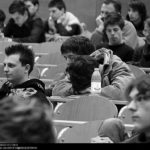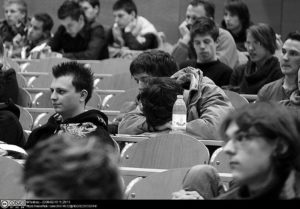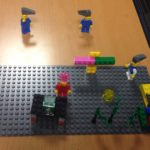I recently read an insightful piece from Charles D. Morrison, which argues, among other things, for a clear distinction between ‘information’ and knowledge’ in educational discourse. Morrison, like many others, holds that while information may be transferred (e.g. through telling or lecturing), knowledge cannot – that is, information must be contextualised, applied, experienced in order to become knowledge. This will be a familiar point to anyone interested in effective pedagogy, but the article is worth a read, not least because it communicates clearly the responsibilities of this for the student as well as the tutor. It’s also a point that bears repeating at this time of year, as we consider the new cohorts of students who have already begun to walk in to our classrooms.
 Everyone, students and tutors alike, will bring something slightly different to the classroom. There will be differences in the prior knowledge and skills students have developed, but there may also be differences in the ways these are integrated into their experience – the preconceptions (and misconceptions) they have created in order to make new information make sense to them. This collection of intellectual baggage is what Phil Race refers to as ‘learning incomes’ – and it can really make a difference to how each student engages with new learning, even in the most carefully designed and structured learning activities. How then to ensure that each of these individuals can progress towards common intended outcomes?
Everyone, students and tutors alike, will bring something slightly different to the classroom. There will be differences in the prior knowledge and skills students have developed, but there may also be differences in the ways these are integrated into their experience – the preconceptions (and misconceptions) they have created in order to make new information make sense to them. This collection of intellectual baggage is what Phil Race refers to as ‘learning incomes’ – and it can really make a difference to how each student engages with new learning, even in the most carefully designed and structured learning activities. How then to ensure that each of these individuals can progress towards common intended outcomes?
Race argues that the best way to do this is to ask them what they already know, using one of our favourite tools here in Learning Design, the humble post-it. In the piece linked above, he describes a simple exercise designed to collate students’ thoughts on the most important thing they already know about a topic, and the biggest question they have. This kind of exercise is useful for helping teaching staff to identify knowledge gaps and misconceptions, but Race also points out another important gain: that “Learners are very relaxed about doing this, as ‘not knowing’ is being legitimised”. This can be particularly important for new students, who may lack confidence in their abilities, because it frames the classroom as a safe space for exploration, experimentation and failure (often a necessary precursor to success!).
If you’re thinking about using a similar diagnostic activity with your new learners this term, you might also find this post from Janet G. Hudson useful, as it includes a few more suggestions on how to gather data on common misunderstandings in your subject. Or, if you’re already using this type of activity, why not share your thoughts below on what has worked well for you?
Written by Sylvie Lomer and Elizabeth Palmer.
“Why should I even be doing this no one else can be bothered…”
“If I think it is going to benefit me then I will do it, if I don’t I won’t”
“It’s all so boring and hard, I can’t be bothered”
These are the kinds of phrases every teacher dreads overhearing in whispers in class, or in the corridors or even straight to our faces! Instead, we hope against hope for the student that at least trusts us enough to go with the flow….
“For me, I just do it anyway even if it’s not compulsory I’m probably going to do it because there’s a good reason someone has set it up”
…and even more so for that keen student, bright eyed at the front, hand raised, prepared and ready to go!
This blog post deals specifically with what might constitute ‘student engagement’ and the fact that it is often hard to tell what ‘non-engagement’ looks like. In addition, it hopefully goes some way towards establishing that there are different ways to support engagement and that both staff and students need to develop the right skills to foster high levels of engagement under active learning pedagogical models.
What is ‘Engagement’?
Active learning gives preference to group work, co-production, discussion and debate because its pedagogical underpinnings are based on relational and social learning theories. Engagement in these activities is, supposedly, easily observable. Students are either talking, writing, creating etc. or not. One of the difficulties faced by lecturers when moving to such models of learning is the discovery that engagement is not, in fact, as easy to measure as one might assume and that the characteristics of engagement that are easily observed in active learning favour more vocal and confident students. This may leave teachers with a group of students who are not observably participating in these activities. This gives rise to concerns about engagement and participation levels. Are those students that are not vocal, not participating, not creating or ‘doing’ the learning task not engaging and by proxy not learning?
If we begin by assuming that engagement is not necessarily:
-
Verbal
-
Written
-
Product-based
-
Observable
-
What teachers expect.
Then what is it and how do we support it?
Fredericks, Blumenfield and Paris (2004) talk about 3 dimensions to engagement: behavioural, emotional, and cognitive. This suggests that a student could exhibit what we might constitute as observable behaviourally positive engagement through regular attendance and completion of all tasks and assignments, but still be emotionally alienated by the material and therefore, not necessarily have learnt anything (cognitive engagement). In this example has the student ‘engaged’ and does that represent quality learning?
An online environment makes visible things which are present in traditional classrooms, but may remain implicit. In online contexts, for example, we might presume that to be engaged, students must be contributing to discussion boards, raising hands in virtual classrooms, writing blog posts, commenting on classmates’ contributions, and so on. But a small proportion of students are watching the discussions unfold. They may still be learning by watching. Indeed this is part of established learning models, such as Kolb’s learning cycle.
Undoubtedly, there are always some in a given group whose silence reflects confusion, uncertainty, sleepiness, or alienation. But arguably, it is possible to listen actively, to take effective notes and learn by doing so. Sometimes silence is an indicator of thought, of processing, of reflection, of listening.
Not all forms of engagement look the same. So how do you as a teacher determine whether silence is problematic or a different form of engagement?
If it’s online, set the tracker on each of your learning activities. You will be able to see who has accessed each learning activity, even if they have not made a written contribution. Contact them and ask what’s going on, non-confrontationally. Look for changes in patterns. A decline or shift in regularity of tracking patterns might indicate that the student is struggling. This requires regular involvement from the tutor, checking the statistics on the VLE and responding to individual students where appropriate.
If it’s face-to-face, ask questions as you circulate through the groups. Check in with students who seem quiet – have they understood the task? are the group dynamics excluding them? Think about whether they can participate in an alternative mode (e.g. make notes and pass them on). Make this check in personal – ask how they are, whether something is going on, this helps students to feel heard as an individual not just a collective.
Once you’ve determined that there is an engagement problem, the next step is to understand why.
What creates barriers to engagement?
Firstly, and fairly obviously, it’s worth considering prior assumptions about why students are not engaging. They may not be engaging for a number of reasons, some of which are outside their control. There is no meaningful category of ‘disengaged students’ and even students exhibiting “inertia, apathy, disillusionment, or engagement in other pursuits” (Krause, 2005, p.4) may have significant and understandable reasons. Indeed students experience different modes of engagement at different times as a continuum rather than as innate characteristics or traits. Whilst some modes of engagement may be desirable and some may not be, categorising students in relation to modes of engagement is unhelpful.
Students may be temporarily disengaged due to personal stress or concerns. They may be more permanently disengaged due to a fundamental breakdown in one or more of the three dimensions of engagement. If a student is in this situation, telling them to engage is probably not going to work. Asking them whether they are OK or why their engagement patterns have changed may be enough to show them that they are heard and seen as a whole person and they may consequently re-engage. Other times it may be necessary to implement a longer term strategy.
Often, it is necessary to address implicit requirements and skills for effective participation in learning activities. For example, many students in their first year are expected to engage in seminar debate and discussion. For many, this is a first. They may not have the requisite transferable skills of listening, building on contributions, negotiating, synthesising, and courteously disagreeing. These are sophisticated, high order thinking skills which are not innate to any of us. Scaffolding activities and modelling good practice, starting with easier tasks and concrete learning activities is vital.
Assumptions about requisite implicit skills extend to teachers as well. Facilitation of discussion and group work is an extremely challenging task and most of us have never been formally taught either how to formulate questions for discussion or how to stimulate and continue the discussion (or other learning activities). Anyone who has been to a conference will know that discussions do not emerge automatically and can be very difficult to manage. It is worth asking, therefore, whether it is our own uncertainties and fears, subconsciously perceived by students, that underlie disengagement. Beginning to address issues of engagement amongst a student cohort invariably starts with necessary self-reflection and personal development. Finding problems with engagement in our classes and recognising we need help is a particularly hard thing to admit to as it can feel like a loss of face. Often we try to identify a solution or solutions on our own, feeling unable to admit to the problem or indeed not knowing where, or from whom, to get support. Engaging in collaborative peer observation that is not in any way linked to performance management processes can be a start to this. Sometimes having a second pair of eyes and ears in the room can help spot things that it is difficult to do alone.
How do I improve engagement?
Our role as teachers, then, is to establish the conditions in which all students can and do engage in different ways at different times. Learning design, in all its facets, is the key means to tackling this effectively.
As a starting point this may mean reflecting on the content. Get engaged/ re-engaged yourself! Are you excited about this session/ module? Do you think this is a really interesting topic? Are you looking forward to spending time with your students? Are you keen to see what they learn and how they respond to the learning activities you have so carefully created? This must seem incredibly obvious, but often over the course of many years of teaching a subject, it is easy to underestimate the power of a teacher’s authentic emotions on the outcome of a class. The demands on a lecturer’s time and emotional energy have increased exponentially over the last few years and it is easy to become alienated ourselves from our discipline and our desire to educate. Our own well-being as practitioners has a significant impact on our students. A sense of excitement about learning and growth within our field is as important for us as it is for our students. Teachers can be gatekeepers for students into their profession, and modelling continuous learning and development offers opportunities to make learning relevant to future practice. If you can communicate your enthusiasm, students will pick up on your engagement. In an active learning model, having projects in your professional field that you are working on and enjoying can be a useful basis for case studies, work experience opportunities for your students, collaborative student research etc.
Secondly, be transparent, open and honest with respect to your pedagogy. If you’re not sure about something, or if you are trying something new and you don’t know how it’s going to work, tell your students. Ask them for their feedback and cooperation. Ask for their help. Most students will be delighted to be treated as equals in this scenario, and very few will take advantage of it. Student agency in the design and implementation of their learning is highly important and often a successful way of raising engagement in a cohort. Equally, give students some control and agency within the learning activities and tasks. For a given task, give choices about how to complete it. This can be individual or a group discussion about how best to complete the task – this is often a brilliant opportunity for meta-cognition or explicit reflection on learning. In relation to technology-enhanced learning this can also be a means of extending digital literacy within a class. Whilst you may not be aware of the range of technology available for a given task, the collective has a wider reach. Provide opportunities for students to share practice to extend learning and tech usage beyond themselves.
Thirdly, engage in staff development to increase your facilitation skills for both face-to-face and online environments, so that in group work you can effectively manage the dominant members of the group in order that there is space for more reticent students to develop their ideas. It can be helpful to alert students in advance so that they can prepare for the activities (e.g. tell them what the discussion topic will be). This gives students more time to process, collect their thoughts, develop arguments etc. before they are required to discuss the content with classmates. In a blended learning scenario, this can be a significant strength. Online preparation activities can be developed to allow students the time to reflect on issues, in advance of face-to-face sessions. Virtual classrooms allow students to raise their hands, ask questions and participate without being seen by the rest of the class. Therefore, use of virtual classrooms in addition to face to face sessions can offer alternative means of participation. Students that might never raise their hand in class normally, often do in an environment that offers greater anonymity and reduces the risk of embarrassment.
Coming back to the 3 dimensions to engagement – behavioural, emotional and cognitive – we can, and must, examine our learning activities and environments to foster all 3 dimensions.
What does that mean for how we understand ‘engagement’?
All of this suggests a need to re-conceptualise the notion of engagement. The key thing is the recognition that student engagement is the responsibility of both students and their institutions (including the teaching staff) (Witkowski, 2015; Morrison, 2014). Dealing with a ‘lack’ of student engagement should, therefore, not constitute a blame game. Instead it is about genuine, open and honest conversations about how learning should take place and what our mutual roles are between those involved in the learning. At Higher Education level the agency of the students is key but must be understood in the context of the structures within institutions. Here’s one possible, working definition:
Student engagement is concerned with the interaction between the time, effort, and other relevant resources invested by both students and their institutions intended to optimise the student experience and enhance the learning outcomes and development of students and development of students and performance and reputation of the institution (Trowler, 2010).
If any of the content of this blog post has caused you to want help in identifying or problem solving for engagement in your module please contact: LD@northampton.ac.uk
References
Fredricks, J.A., Blumenfeld, P.C. and Paris, A.H. (2004) School Engagement: Potential of the Concept, State of the Evidence. Review of Educational Research. 74 (1), pp. 59–109. In: Trowler, V. (2010) Student engagement literature review. Department of Educational Research, Lancaster University. The Higher Education Academy. Available at: http://www.lancaster.ac.uk/staff/trowler/StudentEngagementLiteratureReview.pdf (Accessed on 2nd September 2016)
Krause, K. (2005) Understanding and Promoting Student Engagement in University Learning Communities. Paper presented as keynote address: Engaged, Inert or Otherwise Occupied?: Deconstructing the 21st Century Undergraduate Student at the James Cook University Symposium ‘Sharing Scholarship in Learning and Teaching: Engaging Students’. James Cook University, Townsville/Cairns, Queensland, Australia, 21–22 September. In: Trowler, V. (2010) Student engagement literature review. Department of Educational Research, Lancaster University. The Higher Education Academy. Available at:http://www.lancaster.ac.uk/staff/trowler/StudentEngagementLiteratureReview.pdf (Accessed on 2nd September 2016)
Morrison, Charles D. (2014) “From ‘Sage on the Stage’ to ‘Guide on the Side’: A Good Start,” International Journal for the Scholarship of Teaching and Learning. 8 (1) Article 4. Available at:http://digitalcommons.georgiasouthern.edu/ij-sotl/vol8/iss1/4 (Accessed on 2nd September 2016)
Witkowski, Paula, & Cornell, Thomas. (2015). An Investigation into Student Engagement in Higher Education Classrooms. InSight: A Journal of Scholarly Teaching, 10, pp.56-67.
[Posted on behalf of Elizabeth Palmer]
When starting to make online activities for blended learning there is a temptation to take content that is currently being delivered face-to-face in lectures (through software such as Powerpoint) and moving that content into an online format where the students are ‘digitally page turning’ through material: read or watch x, y and z before class.
The learning and teaching plan for blended learning is that we are creating interactive activities that support students towards developing their own knowledge, understanding and creating outputs that can then be used in class. In other words we are trying to flip the focus away from tutor created content that the student must passively absorb, to student-led interactive and created content.
Any content provided to students should be done in an interactive, discovery based way i.e. rather than telling them the answer we allow them to discover the answer through questioning, testing, trialling, problem solving etc. online and then reinforce and develop this face to face. If you are trying out e-tivities for the first time Xerte can be a useful package to start this process. Have a look at these two examples of using Xerte to make interactive activities on academic skills: here and here. Whilst they are not necessarily perfect, they demonstrate how you can use Xerte’s functionality to create knowledge checking, interactive exercises that you could then build on in class or use as a basis for students to undertake a more complex task.
At recent events, including last week’s Learning and Teaching conference, the Learning Design team have been trying out some new activities to help teaching staff think about how they design for learning. You may have seen some of these new tools and activities described in earlier posts in this category, or had the chance to have a go at using them in development events. In this post I’d like to look at the bigger picture of how these might fit together with some of the other services we offer.
At the conference, we hosted a ‘cracker barrel’ table. The staff that came to see us were offered giant post-its (no small motivation!) in exchange for drawing us a picture of what they value most in their teaching. You can view these in our online album here (we’ll be adding more from other events to this album too):
 |
| What I value most in teaching |
The resulting images were not just works of art. They could also be seen as ‘teaching metaphors’ (McShane 2005). We asked participants to expand on these, and break down what was happening in the image using three key questions:
- what is the role of the tutor?
- what is the role of the student?
- what is the role of technology?
Common themes in the role of the tutor included motivation, guidance, facilitation and enabling, linking learners together and lighting ‘sparks’ and ‘light bulbs’ of understanding. There was also an emphasis on pastoral roles, being ‘approachable’, ’empathetic’ and a ‘confidant’. The role of the student was widely agreed to be participative, with comments noting the importance of engaging, contributing and becoming autonomous. Some comments also noted that the distinction between tutor and student is not so dichotomous, and that learning happens in a community where the participants all learn together. Comments on the role of technology mostly focused on supporting access to learning, as well as ‘fostering community’ and enabling sharing. You can see all the contributions in this PDF file (3.5MB, captured using the Post-It Plus app).
 Sadly that was all we had time for on the day, but we did ask them to go away and think about how their image related to their own programmes and modules. Is that ideal teaching moment what’s happening in those modules now? And if not, what could they change that might enable them to do more of what they value?
Sadly that was all we had time for on the day, but we did ask them to go away and think about how their image related to their own programmes and modules. Is that ideal teaching moment what’s happening in those modules now? And if not, what could they change that might enable them to do more of what they value?
This led me to think about a model that I had been introduced to by our very own Deborah Forbes, in a staff development session on Thriving in a Changing Environment*. The model is Appreciative Inquiry (AI), and as a positive approach to change management it has a lot to offer as we prepare for Waterside. Here’s what some of the experts have to say about AI:
“The traditional approach to change is to look for the problem, do a diagnosis, and find a solution. The primary focus is on what is wrong or broken …Appreciative Inquiry suggests that we look for what works in an organization …Because the statements are grounded in real experience and history, people know how to repeat their success.” (Hammond, 1998, pp.6-7)
And:
“[Appreciative Inquiry] deliberately seeks to discover people’s exceptionality – their unique gifts, strengths, and qualities. It actively searches and recognizes people for their specialties – their essential contributions and achievements. And it is based on principles of equality of voice – everyone is asked to speak about their vision of the true, the good, and the possible.” (Cooperrider, 2001, p.12)
Although there is no one definitive model for AI, the 4-D aproach is widely used. This consists of four main steps:
- Discover: The identification of organisational processes that work well.
- Dream: The envisioning of processes that would work well in the future.
- Design: Planning and prioritising processes that would work well.
- Destiny: The implementation (execution) of the proposed design. (Cooperrider and Whitney, 2005, p.17)
In terms of programme and module design, the steps we covered at the conference were targeted at the ‘discover’ and ‘dream’ stages – by helping staff to think about what works really well for them and their students, they can begin to think about what their programme or module might look like if they did more of it. This begins a process that then feeds in to the beginning of the CAIeRO, where staff are asked to outline their aims for the programme or module, create a mission statement for it, and think about the ‘look and feel’ (see this post for more on this). The CAIeRO process then leads the course team through the ‘design’ stage towards the ‘destiny’ or delivery of the new or re-designed modules.
Do you have positive stories to share about what you love about teaching, what’s working well, and what it should look like in the future? Would you like to contribute to the conversation? Then why not add your comments, send us a picture (along with a brief outline of what’s happening), or write us a case study? You can comment on this post, or email the Learning Design team at LD@northampton.ac.uk.
References:
Cooperrider, D.L. (2001) Why Appreciative Inquiry? In Cooperrider, D.L., Hammond, S. and Royal, C. (eds) Lessons from the Field: Applying Appreciative Inquiry. Plano: The Thin Book Publishing Company.
Cooperrider, D.L. and Whitney, D (2005) Appreciative Inquiry: A positive revolution in change. San Francisco: Berrett-Koehler.
Hammond, S. (1998) The Thin Book of Appreciative Inquiry. Plano: The Thin Book Publishing Company.
McShane, K. (2005) Metaphors for University Teaching. Learning and Teaching in Action. 4(1). Available from: http://www.celt.mmu.ac.uk/ltia/issue10/mcshane.shtml [Accessed 29th May 2015]
* Look out for future sessions on the Staff Development site on NILE (note, you will need to be logged in to NILE for this link to work).
Or, how can Lego help you to build a course or module?
Introduction to Programme Design is a one hour staff development session for new academic staff. The session covers key information that staff need to know about how programme and module design works at the University, including signposts to the frameworks and regulations and an overview of the support available.
To help staff start thinking about the complexity of course design, we gave them some lego and asked them to work in pairs to think about the elements that need to be considered, and how they relate to each other.
Why lego?
Why not? Lego is a simple to use, non-threatening tool that helps to externalise people’s ideas in a visual way. It provides a framework for storytelling, and as you will see from the results below, can help teams to synthesise and communicate big ideas. It’s used in many companies as part of a design thinking approach, to help find creative solutions to complex problems*.
Here are some of the elements that Lego helped us to discuss. Each team was given a standard set, along with a single ‘random’ piece. Click on the thumbnail images to view the full scenes:
This team used the lego to show the lecturer and students working within and co-creating a framework, which included other elements like NILE and QAP. The bridge between the students indicates social learning. The scene also includes ‘steps to success’ and a diving board to launch them into their career. The little eyes indicate institutional oversight, and the web is used to catch the students who are not engaged and enable them to ‘bounce’ back in to the course.
This scene has a student at the centre, as the course design starts from their expectations and needs. Alongside the student is an academic and a member of support staff, indicating working in partnership. The shark is about risk: in the form of competition from other universities, and of distractions from learning – the wall is a protection against this. The raised platform indicates student support, including academic standards, facilities like NILE and IT, and skills for employability.
Stakeholders in this scene include service users and commissioners, who are central to programme design for Health courses, as these must consider the needs of the local area in terms of health provision. Other elements include the resources available (lecturers, skills), and the constraints e.g. professional body regulations and quality frameworks. The elephant is Waterside, which will have a ‘massive’ influence on how we move forward with programme design.
The students in this depiction were widely scattered around the room, indicating the ‘geographically dispersed nature of learning communities’. They are connected by mobile devices. The staff member has a movable ‘office’ (which could be at home, a hotdesk, overseas etc). There are signposts for learners throughout the course. The purpose of the course is to help students achieve educational, career and social mobility, indicated by climbing the ladder.
In this scene, the students (on the left) arrive at different levels and some progress faster than others. The programme lead is looking towards them to help them progress. Ahead is the University management and governance, leading the direction of the University. The horse is University strategy, leaping obstacles and providing support to students. On the right is a platform – both for celebration of success (award ceremony) and as a launchpad to a career.
The exercise helped participants to start thinking about the stakeholders that need to be considered in programme design, the aims of their programme or module, and the ways that students are supported. The discussions showed the complexity of the course design process, and shaped our conversations about how it should be supported.
If you were in this session and would like to expand on your model, or if you weren’t but you’d like to respond to the models (or create your own!), please leave us a comment below.
To sign up for a session, visit the Staff Development organisation on NILE (note: you will need to be logged in to NILE for this link to work).
*Although we didn’t have time to use it in this session, the Lego Serious Play website outlines a full methodology for this approach.
Our colleagues at CfAP are often on the receiving end of poor assessment design. In this post, Kate Coulson, Head of CfAP, describes the impact on the student experience and looks at ways to ensure this won’t happen to your students…
“Maya* is an undergraduate in the second year of her degree. Throughout her first year, she was averaging a C grade in her assessments. Maya has just received her grade and feedback from her first assessment of her second year. She was given a D grade and the marking tutor advised her to visit CfAP to get some support and guidance in “understanding the question”.
When Maya meets with a CfAP Tutor she becomes very distressed and states that “the question didn’t make sense” and “I don’t know what I needed to include”. She also states that she spoke to her tutor directly as she was unclear about the assessment but their conversation left her more confused. When chatting to her course mates about the assessment, they had interpreted the requirements in a totally different way and she panicked and didn’t know what to do.”
When writing questions for essays or assignments it is imperative that you think about the student. Badly written essay questions confuse the student and can affect their confidence and performance in the task – sometimes even leading them to question whether University is the right place for them.
Tips to help you avoid the pitfalls:
- Allow time to plan your questions or tasks.
- Be clear about what knowledge and skills you want the students to demonstrate (these should be informed by your learning outcomes).
- When you are writing a question or task, consider the stage of the programme and module where it takes place, and evaluate whether the students have the content knowledge and the skills necessary to respond adequately.
- When scheduling, be aware of other assessments students will be given from other modules on the programme. Nobody benefits from students having to divide their time and energy between multiple deadlines.
- Discuss the assessment with your students – both the task itself and the purpose of it. Explaining why you have chosen this task, and how it will help them to reach the learning outcomes, will help them feel ownership. Be prepared to adjust in response to valid feedback.
- Share grading criteria and rubrics ahead of the assessment. Students should know what they are aiming for, and what satisfactory performance looks like. Better still, consider writing a model answer. This will help you to reflect on the clarity of the essay question, even if you choose not to share it with the students until after the deadline. It could also serve to inform the grading of students’ responses.
- Use your colleagues to critically review the question or task, the model answer and the intended learning outcomes for alignment.
- Use formative tasks to help students to develop their understanding of expectations and standards. Better still, plan out the ‘assessment journey’ when planning your module, to ensure students have opportunities to learn the process as well as the content of the assessment. The Assessment and Feedback cards from the JISC Viewpoints project can help you do this.
Writing good essay questions is a process that requires time and practice. Review your questions after the students have completed them, think about how the questions have been interpreted. Studying the student responses can help evaluate students’ understanding and the effectiveness of the question for next time.
Useful reading and resources:
The University’s Assessment and Feedback Portal provides more information about assessment design, including links to published research in this area.
The Assessment Brief Design project from Oxford Brookes gives detailed guidance on writing clear and targeted briefs.
For more on the great work done by the Centre for Achievement and Performance, visit the CfAP tab on NILE.
*”Maya” is a fictional character, although her story is based on real events.
In 2010, Roshni Khatri presented on students perceptions of online audio and online text based feedback. Her experiences on feedback were also further disseminated in the Submission and Grading Electronically (SaGE) working group on 17th December, 2014 as they were felt to be still relevant to current cohorts.
Roshni indicated that the majority of students preferred the audio feedback when compared to the online feedback.
Students commented that:
- ‘The online written feedback was visual and suits my learning style.’
- ‘I heard my name and I paid attention!’
- ‘really helpful for me as I am able to go over the proposal and know which bits you are explaining about. I find this more helpful than having written feedback.’
The presentation noted benefits and problems with the process and made suggestions for further work.
A number of staff are designing e-tivities (online learning activities) that require students to undertake some independent research and then share a link to the online resource with peers who can then click on the link and view the article for themselves.
If the article has been found and accessed through NELSON and the link shared with students who are not already authenticated through the University systems then they will be faced with either a dead link or an ‘Access Denied’ message.
In this situation the solution is as follows:
- Ask students to include the full reference for the journal so that potential viewers can access the article themselves via the Library ‘Find My Reference’ tool. By using this route, students will be prompted to login with their University login in order to get access to the article.
If this applies to you, please change your e-tivity instructions to ask for articles to be shared using the University of Northampton Harvard referencing style. Include this link to a Skills Hub video that shows quickly how to use the ‘Find My Reference’ tool. You might also want to include an example of how to reference a journal using the Harvard journal – guidance is available from the Help Tab in NILE.
The added bonus for the students, of course, is practice in Harvard referencing!
With thanks to Hannah Rose, Academic Librarian for helping us with the solution
You might already know that the University has plans to extend our portfolio of high quality blended and online courses. These plans aim to help us meet market demand for flexible, scalable study options, as well as allowing us to bring the campus experience into the 21st century, helping students and staff make the most of valuable contact time. The plans are outlined in more detail in this paper on The University of Northampton’s future online and blended offering, which was approved earlier this year.
In the past few weeks, a key element of this has been put in place with the appointment of Learning Designers, a new role with a remit to help programme teams design effective courses for online and blended learning. The new team is based in Library and Learning Services, working closely with Learning Technologists and CfAP as well as the Institute of Learning and Teaching. Watch this short video to find out more about their role:
(or access the transcript here)
There are three Learning Designers in the new team: Rob Farmer, Rachel Maxwell and Julie Usher. The team will offer a range of design support services, including team CAIeROs and one-to-one support.
Each of the six Schools have nominated priority courses for (re)development, and the team will focus primarily on these in the first instance. If you’d like to find out how the team could support your programme or module, or you have some good practice or learning designs to share, please send initial enquiries to Rob Howe, Head of Learning Technology (rob.howe@northampton.ac.uk).
Last December, Economics Lecturer at NBS, Dr Kevin Deane, took the unusual step of abandoning 4 weeks of his timetabled lecture programme and replacing it with a group exercise culminating in an academic poster exhibition (see this blog posting for more details!)
The exhibition was a real success, particularly for a first-time event, as evidenced by the comments from the students and other NBS staff who attended the exhibition. That said, Kevin has some definite changes and improvements he would introduce next time around. But, in these days of NSS scores and working to improve the student experience, the big question to be answered is … what did the students think?
Generally, their reflections mirrored those of Kevin himself. Apart from an appreciation of the refreshments (!) the following comments are worth mentioning in response to the question of what was good about the task:
- One student responded by saying that the good thing was the “big range of information exchanged and displayed, very insightful. Food was good, getting tutors and guests involved.”
- Another enjoyed the fact that they didn’t have the pressure of an assessed assignment.
- “People did them relatively well. Rewards were good incentive”.
- Another student commented that it “was a great insight into a variety of economists. It provided me with a better understanding of these economists and their philosophies.”
There were some technical hitches on the day of the exhibition itself. In particular, Kevin had been expecting the room to be ready when he and his students arrived, but an error in communication meant that an hour was lost having to set up the exhibition boards. This did have a significant knock-on effect for students as the first hour of the session was lost. This had been scheduled for a student-student presentation of each of the posters, which would have provided the primary opportunity for students to learn about those other economists being studied by their peers.
The following student comments on what could be done differently/better mirror Kevin’s own reflections. Specifically, the students were keen that copies of the other posters were circulated – something Kevin had already planned to do. This is of particular importance pedagogically – where students are creating and generating module content which forms one jigsaw piece of the whole picture, ensuring that each student has access to the full and final picture is essential. Another comment was that it was rightly considered unfair that some students were asked to produce posters on economists that had already been studied in class whereas others were starting from scratch. Looking ahead, Kevin would ensure this didn’t happen again and recognises that it was purely circumstantial, arising from the decision to move away from lecturing to the poster exhibition after the lectures had begun. In itself, this was engendered by student feedback indicating that the lecture approach to this topic was dry and uninteresting.
One final comment worth addressing directly was that students considered the poster to be “too much extra, [it was] not part of our course.” This feedback reflected a failure to appreciate that this poster wasn’t actually ‘extra’ work per se, rather a change in the way the module content was being taught. In future, Kevin would draw attention to the fact that the requirements of producing a poster are no more onerous in terms of the expected study time than indicated in the module spec: 4 students per group x 3 hours per week of independent study x 3 weeks = 36 student study hours per poster.
Other negative comments included the following:
- It was a lot of work, for no obvious reward in terms of assessment.
- Lack of assessment meant no incentive to produce high quality.
- Doing a poster on one subject was limiting.
- Some people didn’t even go.
Having allowed time for both his personal and the students reflections, the following changes would, Kevin believes, improve the exercise next time around:
- Ensuring that the dedicated time for student-student presentations is preserved to ensure that all students receive the benefit of the work done by other groups and learn about all the economists studied in the module
- Explicitly recognise the focus that students place on assessment and grades and therefore turn the task into the first assessment for the module and run it earlier in the academic year when students were not under pressure to complete assessment tasks for other modules
- Ensure that the key points are captured in a summary ‘timeline’ lecture that places them all in context.
Probably the biggest objection he has to overcome is the idea that this task placed an additional burden on students and this really boils down to managing their expectations more explicitly. A clearer explanation and on-going reminder that the poster itself should be the final product of 36 student study hours (9 per student) would go a long way to removing this objection and engendering in students the realisation that this level of work and time investment is, ultimately, what they are at University for!
Recent Posts
- Spotlight on Excellence: Bringing AI Conversations into Management Learning
- Blackboard Upgrade – December 2025
- Preparing for your Physiotherapy Apprenticeship Programme (PREP-PAP) by Fiona Barrett and Anna Smith
- Blackboard Upgrade – November 2025
- Fix Your Content Day 2025
- Blackboard Upgrade – October 2025
- Blackboard Upgrade – September 2025
- The potential student benefits of staying engaged with learning and teaching material
- LearnTech Symposium 2025
- Blackboard Upgrade – August 2025
Tags
ABL Practitioner Stories Academic Skills Accessibility Active Blended Learning (ABL) ADE AI Artificial Intelligence Assessment Design Assessment Tools Blackboard Blackboard Learn Blackboard Upgrade Blended Learning Blogs CAIeRO Collaborate Collaboration Distance Learning Feedback FHES Flipped Learning iNorthampton iPad Kaltura Learner Experience MALT Mobile Newsletter NILE NILE Ultra Outside the box Panopto Presentations Quality Reflection SHED Submitting and Grading Electronically (SaGE) Turnitin Ultra Ultra Upgrade Update Updates Video Waterside XerteArchives
Site Admin










